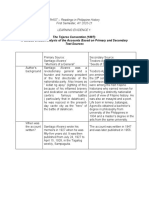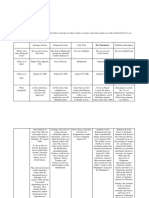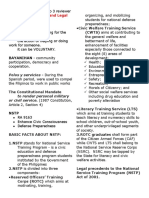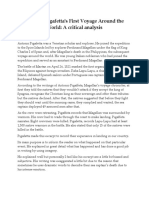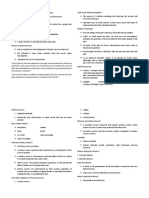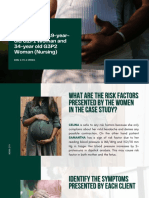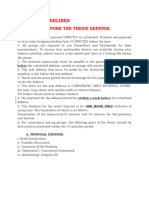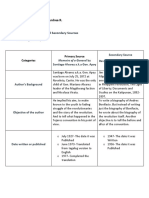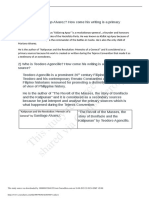STUDOCU - Tejeros Convention Summary 2
STUDOCU - Tejeros Convention Summary 2
Uploaded by
NikoruCopyright:
Available Formats
STUDOCU - Tejeros Convention Summary 2
STUDOCU - Tejeros Convention Summary 2
Uploaded by
NikoruCopyright
Available Formats
Share this document
Did you find this document useful?
Is this content inappropriate?
Copyright:
Available Formats
STUDOCU - Tejeros Convention Summary 2
STUDOCU - Tejeros Convention Summary 2
Uploaded by
NikoruCopyright:
Available Formats
lOMoARcPSD|9736381
READINGS IN PHILIPPINE HISTORY – I. Torres What is the Historical Method?
Historical knowledge is limited by Incompleteness of the Record The process of critically examining and analyzing the records and
survivals of the past
Relevance of History
Historians have to verify sources, to date them, locate their place of
History offers a storehouse of information about how people and origin and identify their intended functions
societies behave.
POINTS TO PONDER
The past causes the present and the future.
Our knowledge of the past will always be partial and incomplete.
History provides a terrain for modern contemplation.
When we think about the past, we have our own assumptions,
Helps provide identity. attitudes and questions which are different from those people of the
A study of history is essential for good citizenship. past.
History as Reconstruction Accounts of the past are always interpretative and always open to
dispute and questions.
Only a small part of what happened in the past was ever observed.
The discipline of history is both less than the past and more than the
The historian is many times removed from the events under past.
investigation.
As an academic discipline, history is an attempt to resolve these
Historians rely on surviving records difficulties and to construct intellectuality coherent accounts of the
“Only a part of what was observed in the past was remembered by those who past which are consistent with the past.
observed it; only a part of what was remembered was recorded; only a part Historical Sources
of what was recorded has survived; only a part of what has survived has
come to the historian’s attention.” Sources – an object from the past or testimony concerning the past on
which historians depend in order to create their own depiction of that
“Only a part of what is credible has been grasped, and only a part of what past. (Howell and Prevenier, From Reliable Sources an Introduction to
has been grasped can be expounded or narrated by the historian.” Historical Method)
Tangible remains of the past
(Anthony Brundage, Going to Sources)
Downloaded by Nikoru (nicolealcesto1025@gmail.com)
lOMoARcPSD|9736381
Written Sources 2. Images
1. Published materials 3. Artifacts
2. Manuscript [any handwritten or typed record that has not been 4. Oral testimony
printed]
What are Secondary Sources?
Non-Written Sources
A secondary source interprets and analyzes primary sources. These
Oral history Artifact sources are one or more steps removed from the event.
Ruins Fossils Secondary sources may have pictures, quotes or graphics of primary
sources in them.
Art works Video recordings
Examples
Audio recordings
History textbook
What are Primary Sources?
Printed materials (serials, periodicals which interprets previous
Testimony of an eyewitness
research)
A primary source must have been produced by a contemporary of the
What is Historical Criticism?
event it narrates.
1. External Criticism
A primary source is a document or physical object which was written
or created during the time under study. 2. Internal Criticism
These sources were present during an experience or time period and External Criticism
offer an inside view of a particular event.
It refers to the genuineness of the documents a researcher uses in a
Primary sources are characterized by their content, regardless of historical study.
whether they are available in original format, in microfilm/microfiche,
It has to do with the authenticity of a document.
in digital format, or in published format.
What is External Criticism?
Four Main Categories of Primary Sources
The problem of authenticity.
1. Written sources
Downloaded by Nikoru (nicolealcesto1025@gmail.com)
lOMoARcPSD|9736381
To spot fabricated, forged, faked documents. 3. Ability to tell the truth
To distinguish a hoax or misrepresentation. 4. Willingness to tell the truth
Tests of Authenticity 5. Corroboration
1. Determine the date of the document to see whether they are Three Major Components to Effective Historical Thinking
anachronistic.
1. Sensitivity to Multiple Causation
2. Determine the author.
2. Sensitivity to Context
3.Anachronistic style
3. Awareness of the interplay of continuity and change in human affairs
4.Anachronistic reference to events
Practical Example/Worksheet
5.Provenance or custody
6. Semantics Topic: Tejeros Convention
7. Hermeneutics Primary Source: Santiago Alvarez’ account
Internal Criticism Secondary Source: Teodoro Agoncillo’s Revolt of the Masses
It refers to the accuracy of the contents of a document.
It has to do with what the document says.
What is Internal Criticism?
The Problem of Credibility
Relevant particulars in the document – is it credible?
Verisimilar
Tests of Credibility
1. Identification of the author
2. Determination of the approximate date
Downloaded by Nikoru (nicolealcesto1025@gmail.com)
lOMoARcPSD|9736381
TEJEROS CONVENTION (1897) Parish house of the Catholic Church at Tanza (Santa Cruz de
Malabon)
■ MEMOIRS OF A GENERAL - General Santiago Alvares
■ Key Personalities
■ Author’s Background
Jacinto Lumbreras, Magdiwang
Born on July 25, 1872
Andres Bonifacio, Magdiwang
He was also a Revolutionary general of the army on the
Magdiwang side. Emilio Aguinaldo, Magdalo
Founder and honorary president of the first directorate of the Santiago Alvarez, Magdiwang
Nacionalista Party.
Daniel Tirona, Magdalo
He is also known as "Kidlat ng Apoy" because of his inflamed
Severeno de las Alas
bravery and dedication as commander of Cavite's famous battles.
Captain General Apoy
He was rejoiced in the present-day Cavite City as the “Hero” of
the Battle of Dalahican. Antonio Montenegro
Died on October 30, 1930. Artemio Ricarte
■ When was the account written? Baldomero Aguinaldo, Magdalo
The memoirs begin on March 14, 1896 when he accompanied ■ Sequencing of events
Emilio Aguinaldo and Raymund Mata during the initiation into the
Assembly at Tejeros was on March 25, 1897 signed by
Katipunan by Andres Bonifacio.
Secretary Jacinto Lumbreras
■ Mention of date(s)
Chairman Lumbreras explained that the K in the middle of the
March 25, 1897 sun in the katipunan flag stands for Kalayaan while Severano de las
Alas highlighted that the flag did not indicate whether the
March 27, 1897
revolutionary government was a democratic or not
■ Mention of place(s)
Captain General Apoy and Mr. Antonio Montenegro argued
Tejeros Convention about the stands as Katipuneros
Downloaded by Nikoru (nicolealcesto1025@gmail.com)
lOMoARcPSD|9736381
When Mr. Lumbreras refused to resume his role as chairman, ■ REVOLT OF THE MASSES - Teodoro Agoncillo
Bonifacio takes the place as presiding Chairman.
■ Author’s Background
Appointed Ricarte as secretary
Born on November 9, 1912 at Lemery, Batangas
Mr. Diego Mojica pointed out that the ballots were already
He was among the first Filipino historians who earned renown
filled out but no by themselves yet Bonifacio regarded this remark.
for promoting a distinctly nationalist point of view of Filipino history
Aguinaldo win the presidency position, Mariano Trias for vice-
Obtained a bachelor's degree in philosophy from the
presidency, General Vibora for captain, Emiliano R. de Dios for
University of the Philippines in 1934
secretary and Bonifacio for secretary for interior was the results of the
election while Daniel Tirona said that the position for interior must be Obtained a master’s degree in the arts from the same
put trust to someone who is a lawyer and because Bonifacio cannot university the following year.
attest with his credentials, let the lawyer Jose del Rosario takes the
Earned his living as a linguistic assistant at the Institute of
place.
National Language and as an instructor at the Far Eastern University
Out of pissed, Bonifacio demands for Tirona’s apology that the and the Manuel L. Quezon University
results must be abide while he pulled out his revolver and aim.
He remained with the University of the Philippines until his
Day after, a meeting at the Tejeros was to be called with the retirement in 1977, chairing the Department of History from 1963 to
Supremo along with the Magdiwang leaders whom waited till 5 in the 1969.
afternoon but no Magdalo came for the reconciliation meeting.
Died on January 14, 1985
March 27, 1897 an eyewitness told that a meeting had taken
■ When was the account written?
place at Tanza Parish house that the decision of Supremo were not
respected. Book was originally published on 1956.
An oath taking has occurred conspicuously with only the ■ Mention of date(s)
absence of the Supremo who was also elected at the election held at
December 1896
Tejeros.
January 2, 1897
April 1897
Downloaded by Nikoru (nicolealcesto1025@gmail.com)
lOMoARcPSD|9736381
March 22, 1897 ■ Idea to elect one supreme council that would hold sway over
the entire province.
■ Mention of place(s)
■ Rebels’ defeat at the hands of Polavieja
Tejeros Convention
■ Third invitation by Mariano Alvares to invite Bonifacio to visit
Parish house of the Catholic Church at Tanza (Santa Cruz de
Cavite
Malabon) - Tejeros Convention, a former summer resort of
the friars that witnessed the first important election held under the ■ Esteban San Juan invited Bonifacio to attend demonstrations
Katipunan government. at Noveleta and followed by a parade.
San Francisco de Malabon, is where the parade happened ■ Leaders of Magdiwang and Magdalo decided to call a
were shouting “ Long live the ruler of the Philippines” convention or assembly at Imus
Zapote, where Emilio Aguinaldo, Candido Tirona and Edilberto ■ Sequencing of events
Evangelista were on hand to meet the Supremo at his entourage.
■ Results of the election was not favor in hands of Bonifacio, he
■ Key Personalities was just appointed as Director of the Interior which was later on being
disapprove by Daniel Tirona through lack of educational attainment.
Andres Bonifacio, Magdiwang
■ Bonifacio felt insulted and determined to pull the trigger at the
Emilio Aguinaldo, Magdalo
ceremony
Santiago Alvarez, Magdiwang
■ He ended up saying that as President of the Supreme Council
Daniel Tirona, Magdalo of the Katipunan, declare this assembly dissolved and annul all that
has been approved and resolved.
Jacinto Lumbreras, Magdiwang
■ Sequencing of events
Severino de las Alas,
■ Bonifacio wrote a letter to Mariano Alvarez saying that there
Artemio Ricarte,
he never expected that his faithfulness would be rewarded with
Mariano Alvarez, Magdiwang avarice and insult as a person.
■ Sequencing of events ■ Bonifacio also sent a letter to his friend Emilio Jacinto telling
that the election was due to bad practices.
Downloaded by Nikoru (nicolealcesto1025@gmail.com)
lOMoARcPSD|9736381
■ DIFFERENCE OF THE TWO ACCOUNTS ■ SANTIAGO ALVAREZ
■ Santiago Alvarez vs. Teodoro Agoncillo The Supremo along with the Magdiwang leaders waited till 5
in the afternoon the following day to continue the meeting happened
■ SANTIAGO ALVAREZ
last Marh 25, 1897 through the invitation of Magdalo President
This account shows that it is General Apoy who withstand with Baldomero Aguinaldo
Antonio Montenegro that said this lines “We of the Katipunan…We
■ TEODORO AGONCILLO
are not bandits who rob others property and wealth”.
The account do not mentioned about the second meeting initiated by
■ TEODORO AGONCILLO
the Magdalo president, Baldomero Aguinaldo.
This account shows that it is Santiago Alvarez who reminded
■ SANTIAGO ALVAREZ
Antonio Montenegro about the recognition of the government
organized by the Association of the Sons of the people. It is Baldomero Aguinaldo whom told that the meeting must
be finished because it is getting dark outside not by Bonifacio.
■ SANTIAGO ALVAREZ
■ TEODORO AGONCILLO
An oath taking was held at the Tanza Parish house in the
absence of the Supremo on March 27, 1897 It is Bonifacio who told the Katipuneros to proceed at the election
because it is already getting dark.
■ TEODORO AGONCILLO
■ SANTIAGO ALVAREZ
The account do not mentioned about the oath taking that
happened at Tanza Parish house. Diego Mojica point out the anomalies on the ballots
distributed by Tirona being already filled out not by themselves but
■ SANTIAGO ALVAREZ
the Supremo just ignored it.
It is stated that the Tejeros Convention for election happened
■ TEODORO AGONCILLO
on March 25, 1897 not March 22, 1897.
It is only a suspicion of Bonifacio that an anomaly was happening but
■ TEODORO AGONCILLO
no direct person whom pointed it out.
It is March 22, 1897 that the Tejeros convention took place just
in time of Aguinaldo’s birthday.
WHO IS MORE ACCURATE, CONSISTENT AND RELIABLE?
Downloaded by Nikoru (nicolealcesto1025@gmail.com)
lOMoARcPSD|9736381
First Voyage around the World • Presented himself to Charles V (now Holy Roman
Emperor), a book written by his own hand, in which were
Antonio Pigafetta
set down the things that happened from day to day during
Background of the Author – ANTONIO PIGAFETTA their voyage.
• Born sometime in 1491 in Vicenza, a town about a • Now known as Magellan's Voyage. A Narrative Account of
hundred kilometers west of Venice, Italy. the First Circumnavigation, a detailed tale of exploration
• Eldest son of Giovanni Pigafetta to second wife Angela and exotica.
Zoga. • Emperor Charles was apparently not impressed, and
• Studied astronomy, geography and cartography Pigafetta received no honor beyond his wages.
• worked in the ships owned by the Knights of Rhodes. • On his way home he passed by Portugal and France and
• Well educated young man, possessing avid curiosity of the shared to the people the things he knew about Magellan’s
world around him.* expedition.
• Joined the delegation of Monsignor Francesco Chieregati • In Italy the Pope was impressed enough to give him
when he was assigned as Papal Nuncio to Spain in 1519. residence while he prepared his manuscript for
• In the same year, he became acquainted with the lucrative publication.
spice trade and heard the news of the voyage to be • *Joined the Knights of St. John of Jerusalem in its battle
undertaken by Ferdinand Magellan. against the Turks.
• Presented his credentials to Magellan and to the Casa de • Died sometime in 1534.
la Contratacion, the office in charged of voyages to New
Historical Context of the Document
World.
• He was admitted as one of the sobresalientes The rivalry between Spain and Portugal in the Iberian Peninsula was
(supernumeraries)* exacerbated by trade as both were interested in exploring and
• Survived the challenges and catastrophes that the developing trade.
expedition encountered along the way and he even got
Both were located in ideal places to start exploring Africa and to start
wounded in the Battle of Mactan.
thinking about trying to round Africa and find a way to the Spice
• Returned to Spain on September 6, 1522 aboard the
Islands in Asia.
Victoria with Juan Sebastian Elcano and more than a dozen
more survivors. The competition between Spain and Portugal became heated enough
that the two countries had to get the pope to divide up the New
Downloaded by Nikoru (nicolealcesto1025@gmail.com)
lOMoARcPSD|9736381
World into parts that would be Spanish and parts that would be This is the copy that is widely circulated in the Philippines.
Portuguese.
Pigafetta’s travelogue contributed immensely to the enrichment of
About the book… Philippine historiography.
Antonio Pigafetta was one of the survivors who kept a journal that His writing described vividly the physical appearance, social life,
became the main source about the first encounter of the Spaniards religious beliefs and cultural practices of the people they encountered
and the Filipinos. in the islands of Samar, Leyte and Cebu.
The original journal of Pigafetta did not survive in history and what His account also contains information about the economic activities
was handed down to us are copies of the manuscript that never came of the local folks and the goods they offered for trade.
out of the press during his life time.
He got all this information through the help Enrique de Malaccca,
Three of them were in French and two are kept in the Bibliotheque Magellan’s slave/interpreter.
Nationale in Paris.
Lastly, Pigafetta gave us an eyewitness account of the Battle of Mactan
The third one was originally owned by the British Collector Sir which resulted to the death of Magellan and him getting wounded.
Thomas Phillipp.
ANALYSIS of the Important HISTORICAL
Later, Beinecke Rare Book bought it and it is now kept in the INFORMATION
Manuscript Library of Yale University in New Haven.
Introduction
About the book…
All information that can be gleaned from the account of
The fourth copy was written in mixed Italian, Spanish and Venetian Antonio Pigafetta in his book, “ First Voyage Around the World” is
language and could be found in Ambrosian Library in Milan. written from the perspective of the writer/author who is a European
(Italian in particular) and therefore a view from the outsider and it
In 1800, Carlo Amoretti published an Italian version of it and the
should be understood in the context of the time. Some descriptions of
following year a French version came out in Paris.
our ancestors; the way the treat visitors, their homes, their customs
Pinkerton of his part translated it to English and published it in 1819. and traditions, foods, and others, are explicitly described and others
are not for these are new to the knowledge of the colonizers. For this,
James A. Richardson made his own English version of the Ambrosian
one should be careful for some of these information are described in
copy and it appeared in The Philippine Islands.
a way that it needs to be analyzed using both perspectives, European
Downloaded by Nikoru (nicolealcesto1025@gmail.com)
lOMoARcPSD|9736381
and our own (i.e. words and terminologies). Furthermore, for it is the Spanish colonizers arrived at Zamal
more fitting, that the “pantayong pananaw” is employed for the
(Samar) [no need to add one day for this
presentation of the analysis.
is not yet covered by the International
Ferdinand Magellan (Portugese – Fernao de Magalhaes) – captain-
general (leader) of the expedition March 17, 1521 – their captain-general desired to land at Humunu
(Homonhon) and which he named, Acquada da li buoni Segnialli
Antonio Pigafetta (Italian) – official chronicler of the expedition
(“the Watering-place of Good Signs) and later the entire group of
Raia Colambu (Raja Kulambu) – king of Mazaua (Limasawa) island as Archepalago of St. Lazaro
Raia Siaui (Raja Siagu) – king of Butuan March 18, 1521 – they met and exchanged goods with our ancestor
from the island of Zuluan
Raia Humabon – king of Zubu (Cebu)
March 25, 1521 – they weight anchored and changed course toward
Raia Cilapulapu and Raia Zula - chiefs (kings) of Matan (Mactan)
west southwest
Latitudes and Leagues!
March 28, 1521, they anchored near the island of Mazaua (Limasawa)
(Geographical Position of the Islands)
and they met the king who came in balanghai
Zamal – three hundred leagues from the islands of Ladroni
March 29, 1521 (Holy Friday) – they finally met the king who entered
Mazaua – (latitude) nine (degrees) and two-thirds degrees toward the their ship
Arctic Pole, (longitude) one hundred and sixty-two degrees from the
March 31, 1521 (Easter Sunday) – they went ashore to say mass and
line of demarcation, and twenty-five leagues from the Acquada
set up cross on the summit of the mountain
(Humunu-Homonhon)
April 7, 1521 (Sunday) – they entered the port of Zubu (Cebu)
Twenty leagues from Mazaua to Gatighan
Monday – their notary together with their interpreter went ashore to
Fifteen leagues from Gatighan to Zubu (Cebu)
met with the king of Zubu
Tuesday – the king of Mazaua and later the prince of Zubu went
(Chronology of Dates)
aboard their ship
March 16, 1521 (dawn of Saturday) –
Downloaded by Nikoru (nicolealcesto1025@gmail.com)
lOMoARcPSD|9736381
Wednesday – they consecrated the place and buried their two dead Wore cotton cloth all embroidered with silk which covered him from
crews the waist to the knees
Friday – they showed our ancestors with different merchandise Some have spots of gold on every tooth
April 14, 1521 (Sunday) – they baptized our ancestors from Zubu and Some are perfumed with storax and benzoin
few from neighboring islands
Wore armlets and other rings for the feet
April 26, 1521 (Friday) – Raia Zula came to seek help to fight the other
Wore necklace of great value
chief of Matan, Cilapulapu
Others (men)
April 27, 1521 (Saturday) – the Spaniards wave ashore in the island of
Matan and fighting commenced between them and men of Raia Naked, with cloth woven from a bark of a tree about (cover) their
Cilapulapu and led to the death of Magallanes privies
May 1, 1521 (Wednesday) – 21 Spaniards were massacred by the Dark, fat and painted (tattooed)
Zubuanos thus forcing the remaining Spaniards to depart Zubu
Anointed with their bodies with coconut and beneseed oil as a
immediately
protection against sun and wind
Are We the Same?
Some have dark hair that hung to the waist
(Descriptions of Our Ancestors)
Have their penises pierced from one side to the other near the head
Seignior (king/chief)
with a gold or tin bolt as large as a goose quill.
Matured (old man in some encounters)
Others (Women)
Some are bit larger than his men and the finest looking man
Clad in tree cloth from waist down
Some are painted (tattooed)
Hair is black and reaches the ground
Wore gold earrings
They are as white and as large as the Spaniards
Some have black hair and hung to shoulders
Holes on their ears which are filled with gold (earrings)
Head covered with silk (kerchiefs)
Downloaded by Nikoru (nicolealcesto1025@gmail.com)
lOMoARcPSD|9736381
Constantly chewing a fruit which they call areca which resembles a • Our ancestor are heavy drinkers
pear, cut into four and wrapped with betre (betel) leaves
• Before the king drinks, he raised his clasped hands towards the sky
Women age six upward have their vaginas gradually opened because and then towards the person he is drinking with and the former
of the men’s penises extends his fist of the left hand towards the latter
• Sometimes they have a meal that would last for six hours
The Cultural Milieu Entertainment
(Customs, Traditions and more…)
• Our ancestor played musical instruments like drums, metallic discs,
Thanksgiving/Gratitude gongs and bells
• Raised clasped hands and face towards the sky and then turned to • Also, our ancestors can dance
others
o Religion
Friendship (casi-casi)
• Our ancestors don’t have formal religion but they have God which
• A ritual of friendship wherein one has to shed a drop of his blood they call “Abba”
from his right arm and the other will do the same and partake each
• Although, no religion they have idols made of wood, hollow and lack
other’s blood
of back parts
Marriage
Food
• One can have many wives as they wish but one of them is the
• Our ancestors eat umay (rice), coconut, meat and fish, and drink
principal wife
uraca (arrack) – a wine taken from palm (coconut)
Trade
Animals and Other Produce
• Our ancestor have a custom that all ships that will enter their port
• Dogs, cats, swine, fowls, goats, rice, ginger, coconuts, figs (banana),
should pay tribute
oranges, lemons, millet, panicum, sorgo, wax and gold
o Festivities
o Dwellings
Downloaded by Nikoru (nicolealcesto1025@gmail.com)
lOMoARcPSD|9736381
• Built up from the ground on huge posts of wood and thatched with fig her daughter (wife of the Prince) - Catherina
and palm leaves
Queen of Mazaua – Lisabeta
Word Game!
(Terminologies)
uraca (arrack) – palm wine, this resembles tuba at present
(h)umay – rice
caphri – heathen
CONTRIBUTION
anime – a gum of a tree wrapped in palm or fig (banana) leaves for AND
lights RELEVANCE OF PIGAFETTA’s DOCUMENT
baloto – small boat On Geography
balanghai – big boat (resembles fusta in Spanish) The Pigafetta document gave a detailed chronicle of the significant
events of the exploration of Ferdinand Magellan.
aghon – gongs (resembles bells in Spanish)
It provided a description, location and distances of the places visited
laghan – a large sea snails which kills whales by eating whale’s heart
thereby enhancing the knowledge of cartography at that time.
What’s in a name?
The chronicle contributed immensely to European historiography
(Christian Names given to our Ancestors)
because it preserved and popularized the achievements of the
Conversion of our Ancestors Magellan-Elcano expedition.
Raia Humabon – Don Carlos On Economics and Trade
Son of Raia Humabon (prince) – Fernando There was an evidence of agricultural activities based on their
produce.
Raia Culambo – Johanni
They engaged in trade with neighboring countries such as China.
A Muslim - Christoforo
On arts, customs, traditions and religion
Queen (Amihan) – Johanna
Downloaded by Nikoru (nicolealcesto1025@gmail.com)
lOMoARcPSD|9736381
As described, Filipinos have their unique musical instruments;
They have arts as seen in their bodies being tattooed (in some
villages);
Performed rituals during dining and some gatherings;
They have a lot of burial practices;
Worship of anitos (wooden idols) and ritual for healing of ill persons.
On the other hand, the document also narrated the status
(inferiority) of the Filipinos in some ways such as;
Warfare - weapons
Manner of dressing
System of writing
On Christianization
The documents narrated the conversion of early Filipinos into
Christianity
at present…..
textbook writers use his book as their source of historical
information every time they discuss the beginning of Christianity in
the Philippines. Their accounts about the first mass in the Philippines,
the conversion of Rajah Humabon and his wife and the story of the
image of the Sto. Nino were mostly taken from Pigafetta’s book.
GOOD LUCK. MAY THE ODDS BE ALWAYS IN YOUR FAVOR! �
Downloaded by Nikoru (nicolealcesto1025@gmail.com)
You might also like
- Reinforcement Act 6Document6 pagesReinforcement Act 6Ancaja, Jameir 1CNo ratings yet
- Ncma219 Course Task 4Document3 pagesNcma219 Course Task 4NikoruNo ratings yet
- STUDOCU - Customs of The Tagalogs SummaryDocument5 pagesSTUDOCU - Customs of The Tagalogs SummaryNikoru50% (2)
- Understanding History: A Primer of Historical Method by Louis GottschalkDocument10 pagesUnderstanding History: A Primer of Historical Method by Louis Gottschalkbry uyNo ratings yet
- Riph - Prelim Reviewer + ExcerptsDocument48 pagesRiph - Prelim Reviewer + ExcerptsNikoruNo ratings yet
- English4 q1 Mod7 EnrichingYourVocabulary v2Document19 pagesEnglish4 q1 Mod7 EnrichingYourVocabulary v2Nikoru100% (1)
- Riph - Prelim ReviewerDocument12 pagesRiph - Prelim ReviewerNikoru100% (3)
- Ethics - Prelim ReviewerDocument18 pagesEthics - Prelim ReviewerNikoruNo ratings yet
- LE1 Tejeros ConventionDocument4 pagesLE1 Tejeros ConventionMecha VelosoNo ratings yet
- Sequencing HISTORYDocument4 pagesSequencing HISTORYAlec Mackadelic71% (7)
- Riph 111 PrelimsDocument17 pagesRiph 111 PrelimsrosieeepanganNo ratings yet
- RIPH QUIZ Controversies On The Site of The First MassDocument7 pagesRIPH QUIZ Controversies On The Site of The First MassLyra Via MagnoNo ratings yet
- Purc Transes PrelimDocument4 pagesPurc Transes PrelimGelo AlonzoNo ratings yet
- Safe Safe SafeDocument14 pagesSafe Safe SafeBea RossetteNo ratings yet
- Introduction of TaekwondoDocument28 pagesIntroduction of Taekwondoalex100% (1)
- Readings in Philippine History: Reviewer For Midterms: Definition of HistoryDocument11 pagesReadings in Philippine History: Reviewer For Midterms: Definition of HistoryRouen Capulong100% (1)
- Unit 5 Topic 2 Appreciating The Philippine Indigenous ArtDocument6 pagesUnit 5 Topic 2 Appreciating The Philippine Indigenous ArtTV BOX MXQ PRONo ratings yet
- Lesson 2 Content and Contextual Analysis of Selected Primary Sources in Philippine HistoryDocument10 pagesLesson 2 Content and Contextual Analysis of Selected Primary Sources in Philippine HistoryAntenorio Nestlyn MaeNo ratings yet
- GEC. 102 - UNIT 3 - ModuleDocument25 pagesGEC. 102 - UNIT 3 - ModuleRomelyn Cuadra MaglangitNo ratings yet
- Gec 2 Chapter 2 1Document45 pagesGec 2 Chapter 2 1Michiko XsNo ratings yet
- Riph Midterm QuizDocument4 pagesRiph Midterm QuizChini RuizNo ratings yet
- Site of The First MassDocument18 pagesSite of The First MassKim Austria TubioNo ratings yet
- Riph ReviewerDocument30 pagesRiph ReviewerKrisha Mabel TabijeNo ratings yet
- SSP 112 Lesson 3Document15 pagesSSP 112 Lesson 3Aubrey PapilotaNo ratings yet
- RPH TQ PrelimDocument2 pagesRPH TQ PrelimFranz Joshua MeridaNo ratings yet
- Prelim Reviewer in The Readings in The Philippine History 2nd Sem 2019 2020 Super Final PDFDocument2 pagesPrelim Reviewer in The Readings in The Philippine History 2nd Sem 2019 2020 Super Final PDFAthena Irish LastimosaNo ratings yet
- RPH Chapter 3 Content and Contextual Analysis - Based On Pre-Colonial Events Particularly in The - Gold Is Used For PaymentDocument4 pagesRPH Chapter 3 Content and Contextual Analysis - Based On Pre-Colonial Events Particularly in The - Gold Is Used For PaymentLalaluluNo ratings yet
- Japanese Colonial Period QuizDocument4 pagesJapanese Colonial Period QuizJuancho OsorioNo ratings yet
- Reviewer in Readings in Philippine HistoryDocument2 pagesReviewer in Readings in Philippine HistoryjussNo ratings yet
- Magellans ExpeditionDocument3 pagesMagellans ExpeditionWELMEN UGBAMINNo ratings yet
- Lesson 1 Also Considers The FollowingDocument20 pagesLesson 1 Also Considers The FollowingAisha Lopez100% (1)
- Module I: Introduction To The Study of HistoryDocument4 pagesModule I: Introduction To The Study of Historyever existenceNo ratings yet
- (RPH) Butuan or Limasawa - The Site of The First Mass in The PhilippinesDocument7 pages(RPH) Butuan or Limasawa - The Site of The First Mass in The PhilippinesCarla Rica GutierrezNo ratings yet
- Tabon Man (William Scott Compared To Robert Fox)Document1 pageTabon Man (William Scott Compared To Robert Fox)Franc Mike Jaryx TobiasNo ratings yet
- First CryDocument3 pagesFirst CryJOHNDANIEL MORATILLONo ratings yet
- Correct Answer:: Council of Advisers To The GovernorDocument14 pagesCorrect Answer:: Council of Advisers To The GovernorJulhayda FernandoNo ratings yet
- History of English in 10 MinutesDocument3 pagesHistory of English in 10 MinutesCarlos Eduardo Rosado TorresNo ratings yet
- Joven FibonacciDocument2 pagesJoven FibonacciZer John GamingNo ratings yet
- Module 5 Art and PhilosophyDocument27 pagesModule 5 Art and PhilosophyMark LouieNo ratings yet
- Meaning of Service: Lesson 1 - Historical and Legal Bases of NSTPDocument5 pagesMeaning of Service: Lesson 1 - Historical and Legal Bases of NSTPMherwin Retanal100% (1)
- The Act of Proclamation of Independence of The Filipino PeopleDocument2 pagesThe Act of Proclamation of Independence of The Filipino PeopleSamantha LadridoNo ratings yet
- The Site of The First MassDocument44 pagesThe Site of The First Massnothing twoNo ratings yet
- Bellesco - Gec105 - Midterm ExamDocument4 pagesBellesco - Gec105 - Midterm ExamAnton Omamos BellescoNo ratings yet
- READINGS IN PHILIPPINE HISTORY - (2ND YR. COLLEGE 1ST. SEM.) - Prelim - Lesson - 1 - (RIPH)Document83 pagesREADINGS IN PHILIPPINE HISTORY - (2ND YR. COLLEGE 1ST. SEM.) - Prelim - Lesson - 1 - (RIPH)Roeven YawriNo ratings yet
- Katipunan - Philippine RevolutionDocument40 pagesKatipunan - Philippine RevolutionDaryll Francisco0% (1)
- Purposive HandoutsDocument10 pagesPurposive HandoutsRoller CoasterNo ratings yet
- Ge02 CHP 4 l1 Monastic Supremacy in The Philippines Merged CompressedDocument73 pagesGe02 CHP 4 l1 Monastic Supremacy in The Philippines Merged CompressedJacoba, Michaela JasmineNo ratings yet
- Manunggul JarDocument5 pagesManunggul JarSeverino MarzanNo ratings yet
- Riph Module Outline Midterm CoverageDocument5 pagesRiph Module Outline Midterm CoverageKENNETH HERRERANo ratings yet
- STS PPT Week 4Document16 pagesSTS PPT Week 4John Michael OralloNo ratings yet
- Module 1 Section 2 Lecture Slides STUDENTDocument29 pagesModule 1 Section 2 Lecture Slides STUDENTJewela NogasNo ratings yet
- Riph Prelim ReviewerDocument23 pagesRiph Prelim ReviewerMj NuarinNo ratings yet
- Lesson 2Document45 pagesLesson 2Jaymar Jade Paganao Ada-olNo ratings yet
- Readings in Philippine HistoryDocument9 pagesReadings in Philippine HistoryEddie Agbayani Jr.No ratings yet
- First Mass Cavite Mutiny Kabata The Cry - Quiz 2 Question 2Document4 pagesFirst Mass Cavite Mutiny Kabata The Cry - Quiz 2 Question 2Cassie CutieNo ratings yet
- Readings in Philippine History: 1.1 Meaning and Relevance of HistoryDocument5 pagesReadings in Philippine History: 1.1 Meaning and Relevance of HistoryNathalie UbaNo ratings yet
- Duties of The The FilipinoDocument2 pagesDuties of The The FilipinoI Need Some SleepNo ratings yet
- Antonio Pigafetta's First Voyage Around The World: A Critical AnalysisDocument2 pagesAntonio Pigafetta's First Voyage Around The World: A Critical AnalysisDCRUZNo ratings yet
- Module 3. One Past But Many Histories Controversies .... 9 15 2020 PDFDocument32 pagesModule 3. One Past But Many Histories Controversies .... 9 15 2020 PDFEina Delos SantosNo ratings yet
- Revolutionary Beginnings: The History of The Philippine FlagDocument22 pagesRevolutionary Beginnings: The History of The Philippine FlagMark Anthony FrancoNo ratings yet
- Topic 1&2 Assessment:: Great Man Theory 4.which Theory Suggests That History Is The Study of ImportantDocument3 pagesTopic 1&2 Assessment:: Great Man Theory 4.which Theory Suggests That History Is The Study of ImportantCamille LatidoNo ratings yet
- STS Module 1 NotesDocument5 pagesSTS Module 1 NoteschynnaNo ratings yet
- Report On Tabon CaveDocument33 pagesReport On Tabon CaveAishlly Crystal OrtizNo ratings yet
- Module and Activity (RPH) The First MassDocument5 pagesModule and Activity (RPH) The First MassAndruey EspirituNo ratings yet
- Lesson 7 Site of The First MassDocument15 pagesLesson 7 Site of The First MassJordan Reyes MosuelaNo ratings yet
- INSTRUCTION. Write A Haiku' With A Theme That Talks About "My Happiness in Pandemic." Also, IncludeDocument1 pageINSTRUCTION. Write A Haiku' With A Theme That Talks About "My Happiness in Pandemic." Also, IncludeJohn Christian EsmejardaNo ratings yet
- Readings in Philippine HistoryDocument14 pagesReadings in Philippine HistoryEmelyn75% (8)
- Readings in Philippine History - I. Torres: Historical Knowledge Is Limited by Incompleteness of The RecordDocument14 pagesReadings in Philippine History - I. Torres: Historical Knowledge Is Limited by Incompleteness of The RecordGwen Miguelle DavidNo ratings yet
- History RevDocument2 pagesHistory RevThereseNo ratings yet
- Ncma219 Course Task 5Document5 pagesNcma219 Course Task 5NikoruNo ratings yet
- Ncma219 Course Task 3Document18 pagesNcma219 Course Task 3NikoruNo ratings yet
- Ncma219 Course Task 2Document6 pagesNcma219 Course Task 2NikoruNo ratings yet
- Defense Guidelines 2021Document3 pagesDefense Guidelines 2021Nikoru100% (2)
- Performance Task #3 - Alcesto (BSN 2-Yb3-Irreg.)Document4 pagesPerformance Task #3 - Alcesto (BSN 2-Yb3-Irreg.)NikoruNo ratings yet
- Performance Task #2 - Alcesto (BSN 2-Yb3-Irreg)Document2 pagesPerformance Task #2 - Alcesto (BSN 2-Yb3-Irreg)NikoruNo ratings yet
- TCWD - Prelim ReviewerDocument11 pagesTCWD - Prelim ReviewerNikoruNo ratings yet
- Funda Lab - Prelim ReviewerDocument16 pagesFunda Lab - Prelim ReviewerNikoruNo ratings yet
- Riph - Prelim ReviewerDocument12 pagesRiph - Prelim ReviewerNikoruNo ratings yet
- Performance Task #2 - Alcesto (BSN 2-Yb3-Irreg.)Document2 pagesPerformance Task #2 - Alcesto (BSN 2-Yb3-Irreg.)NikoruNo ratings yet
- Ethics - Prelim ReviewerDocument18 pagesEthics - Prelim ReviewerNikoruNo ratings yet
- Pe 3 - Prelim ReviewerDocument3 pagesPe 3 - Prelim ReviewerNikoruNo ratings yet
- EXCERPT 4 - Apolinario MabiniDocument8 pagesEXCERPT 4 - Apolinario MabiniNikoru100% (1)
- Funda Lec - Prelim ReviewerDocument15 pagesFunda Lec - Prelim ReviewerNikoru100% (1)
- Team Only One - Rasmey MarcosDocument26 pagesTeam Only One - Rasmey MarcosRasmey MarcosNo ratings yet
- Reaction Paper On Tejeros Convention No. 1Document2 pagesReaction Paper On Tejeros Convention No. 1stephen geraliNo ratings yet
- Readings in The Philippine History ReviewerDocument8 pagesReadings in The Philippine History ReviewerAli CiaNo ratings yet
- Readings in Philippine HistoryDocument36 pagesReadings in Philippine HistoryJasmine PimentelNo ratings yet
- Source: Santiago V. Alvarez, General For The Katipunan: Tejeros ConventionDocument12 pagesSource: Santiago V. Alvarez, General For The Katipunan: Tejeros ConventionJomar CatacutanNo ratings yet
- Comparing Primary and Secondary Sources Learning Activity 1: Raymundo, Michaela Andrea R. HM1A ZGE1106Document4 pagesComparing Primary and Secondary Sources Learning Activity 1: Raymundo, Michaela Andrea R. HM1A ZGE1106michaela raymundoNo ratings yet
- Professional Classic Accounting Book Slideshow For BusinessDocument10 pagesProfessional Classic Accounting Book Slideshow For BusinessGeni AshuraNo ratings yet
- History PPT ReportDocument19 pagesHistory PPT ReportHannah Joy Mari100% (3)
- BonifacioDocument3 pagesBonifacioMarianette CainongNo ratings yet
- Module 2 Readings in The Philippine HistoryDocument62 pagesModule 2 Readings in The Philippine HistoryJUN MACATANGAY100% (1)
- Lesson 14 Historical Background of Philippine Democratic PoliticsDocument76 pagesLesson 14 Historical Background of Philippine Democratic PoliticsGelmar Clemente77% (13)
- KatipunanDocument71 pagesKatipunanYkee PogieNo ratings yet
- Activity 2Document7 pagesActivity 2Shaneen AdorableNo ratings yet
- Document Santiago Alvarez' "Memoir of A General": Name: AGUSTIN, Angela Shane M. - Section BSN 1-ADocument2 pagesDocument Santiago Alvarez' "Memoir of A General": Name: AGUSTIN, Angela Shane M. - Section BSN 1-AShane AgustinNo ratings yet
- Worksheet For Primary VS - OdangoDocument7 pagesWorksheet For Primary VS - Odangoclint xavier odangoNo ratings yet
- Activity #1Document3 pagesActivity #1Jafet LlaneraNo ratings yet
- Readings in PH History Life and Works of RizalDocument14 pagesReadings in PH History Life and Works of RizaljulieanncortezanoNo ratings yet
- Riph Book 35 38Document5 pagesRiph Book 35 38Gilbert BantaNo ratings yet
- Andrés Bonifacio: Bonifacio Spanish Name Family NameDocument29 pagesAndrés Bonifacio: Bonifacio Spanish Name Family NameKenPaiNethNo ratings yet
- Source Brief Description of The Source The Competence of The Author Origin of The Information Narrated Date of The Information and MilieuDocument7 pagesSource Brief Description of The Source The Competence of The Author Origin of The Information Narrated Date of The Information and MilieuMatthewUrielBorcaAplaca100% (2)
- Activity in RPH (Film Review)Document6 pagesActivity in RPH (Film Review)Fiona Xandra San JuanNo ratings yet
- RIPH - HistoryDocument29 pagesRIPH - HistoryJasmine Fritz CabreraNo ratings yet
- Readings in Philippine HistoryDocument14 pagesReadings in Philippine HistoryEmelyn75% (8)
- Week 13 14Document6 pagesWeek 13 14Janna Broqueza RodriguezNo ratings yet
- History Quiz ReviewerDocument11 pagesHistory Quiz Reviewerela kikayNo ratings yet
- Daisy Ge HistDocument32 pagesDaisy Ge HistDaisy AbanNo ratings yet
- The Tejeros ConventionDocument2 pagesThe Tejeros ConventionAafiyah TamanoNo ratings yet








